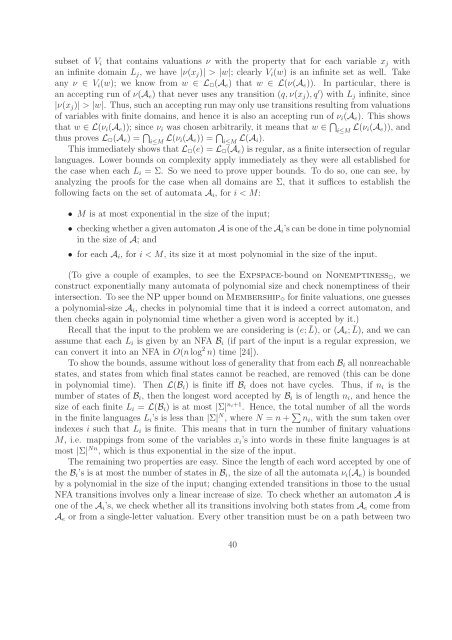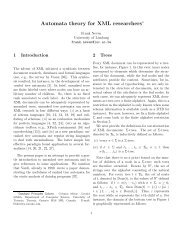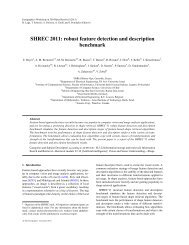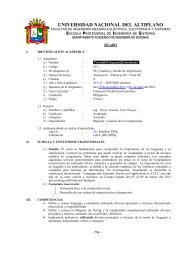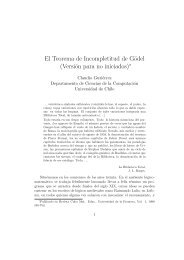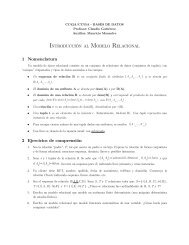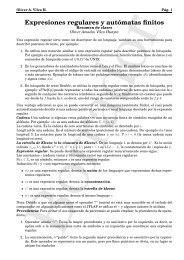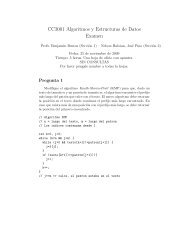Parameterized Regular Expressions and Their Languages
Parameterized Regular Expressions and Their Languages
Parameterized Regular Expressions and Their Languages
You also want an ePaper? Increase the reach of your titles
YUMPU automatically turns print PDFs into web optimized ePapers that Google loves.
subset of V i that contains valuations ν with the property that for each variable x j withan infinite domain L j , we have |ν(x j )| > |w|; clearly V i (w) is an infinite set as well. Takeany ν ∈ V i (w); we know from w ∈ L ✷ (A e ) that w ∈ L(ν(A e )). In particular, there isan accepting run of ν(A e ) that never uses any transition (q,ν(x j ),q ′ ) with L j infinite, since|ν(x j )| > |w|. Thus, such anaccepting runmayonlyuse transitionsresulting fromvaluationsof variables with finite domains, <strong>and</strong> hence it is also an accepting run of ν i (A e ). This showsthat w ∈ L(ν i (A e )); since ν i was chosen arbitrarily, it means that w ∈ ⋂ i≤M L(ν i(A e )), <strong>and</strong>thus proves L ✷ (A e ) = ⋂ i≤M L(ν i(A e )) = ⋂ i≤M L(A i).This immediately shows that L ✷ (e) = L ✷ (A e ) is regular, as a finite intersection of regularlanguages. Lower bounds on complexity apply immediately as they were all established forthe case when each L i = Σ. So we need to prove upper bounds. To do so, one can see, byanalyzing the proofs for the case when all domains are Σ, that it suffices to establish thefollowing facts on the set of automata A i , for i < M:• M is at most exponential in the size of the input;• checkingwhetheragivenautomatonAisoneoftheA i ’scanbedoneintimepolynomialin the size of A; <strong>and</strong>• for each A i , for i < M, its size it at most polynomial in the size of the input.(To give a couple of examples, to see the Expspace-bound on Nonemptiness ✷ , weconstruct exponentially many automata of polynomial size <strong>and</strong> check nonemptiness of theirintersection. To see the NP upper bound onMembership ✸ for finite valuations, oneguessesa polynomial-size A i , checks in polynomial time that it is indeed a correct automaton, <strong>and</strong>then checks again in polynomial time whether a given word is accepted by it.)Recall that the input to the problem we are considering is (e; ¯L), or (A e ; ¯L), <strong>and</strong> we canassume that each L i is given by an NFA B i (if part of the input is a regular expression, wecan convert it into an NFA in O(nlog 2 n) time [24]).To show the bounds, assume without loss of generality that from each B i all nonreachablestates, <strong>and</strong> states from which final states cannot be reached, are removed (this can be donein polynomial time). Then L(B i ) is finite iff B i does not have cycles. Thus, if n i is thenumber of states of B i , then the longest word accepted by B i is of length n i , <strong>and</strong> hence thesize of each finite L i = L(B i ) is at most |Σ| n i+1 . Hence, the total number of all the wordsin the finite languages L i ’s is less than |Σ| N , where N = n+ ∑ n i , with the sum taken overindexes i such that L i is finite. This means that in turn the number of finitary valuationsM, i.e. mappings from some of the variables x i ’s into words in these finite languages is atmost |Σ| Nn , which is thus exponential in the size of the input.The remaining two properties are easy. Since the length of each word accepted by one ofthe B i ’s is at most the number of states in B i , the size of all the automata ν i (A e ) is boundedby a polynomial in the size of the input; changing extended transitions in those to the usualNFA transitions involves only a linear increase of size. To check whether an automaton A isone of the A i ’s, we check whether all its transitions involving both states from A e come fromA e or from a single-letter valuation. Every other transition must be on a path between two40


